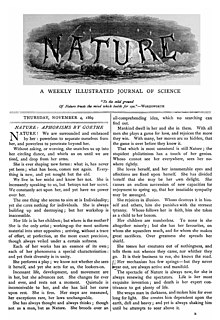Impact factor
measure of mean number of citations per article of an academic journal
The impact factor (IF) or journal impact factor (JIF) of an academic journal is a scientometric index which reflects the yearly average number of citations to recent articles published in that journal. It is frequently used as a proxy for the relative importance of a journal within its field; journals with higher impact factors are often deemed to be more important than those with lower ones. The impact factor was devised by Eugene Garfield, the founder of the Institute for Scientific Information (ISI). Impact factors are calculated yearly starting from 1975 for journals listed in the Journal Citation Reports (JCR).

Quotes
edit- I would like to comment on the statement by Prof. H-J. Oestern and Prof. J. Probst of the German Trauma Society which appeared in the October 1997 issues of your journal as well as the Anaesthesist. The authors assert that the work of German specialists in these fields is published "primarily" in German language journals. And without any supporting data they assert that the impact factor is not appropriate for judging scientific achievements in trauma surgery and most important that "its use leads to an unjustified disadvantage in comparison with other fields."
Where has it been written that such comparisons should be made? In a series of unrelated assertions, none of which are supported by data, claims of bias are made repeatedly. Would these authors assert that German scientists, even in trauma surgery, do not publish in the international journals? In 1997, scientists from Germany published over 77,000 papers in Science Citation Index covered journals -- almost 7.8% of the total ISI database. About 12,000 of those articles were published in German. - It is absurd to make invidious comparisons between specialist journals and multi-disciplinary general journals like Nature and NEJM. To compare journals you should stick to a particular category as is explained very carefully in the Guide to Journal Citation Reports.
- Citation data and analysis should always be used in combination with other indicators when evaluating departments or individuals. For nation by nation comparisons, there is very little controversy about the use of citation indicators. Further, they have been used in the USA to evaluate 5,000 departments at the leading universities. Similar research assessment exercises are performed in the UK.
- Garfield, Eugene (June 1998). "The Impact Factor and Using It Correctly". Der Unfallchirurg. 101 (6): 413–414.
- Impact Factor is not a perfect tool to measure the quality of articles but there is nothing better and it has the advantage of already being in existence and is, therefore, a good technique for scientific evaluation. Experience has shown that in each specialty the best journals are those in which it is most difficult to have an article accepted, and these are the journals that have a high impact factor. Most of these journals existed long before the impact factor was devised. The use of impact factor as a measure of quality is widespread because it fits well with the opinion we have in each field of the best journals in our specialty.
...
In conclusion, prestigious journals publish papers of high level. Therefore, their impact factor is high, and not the contrary.- Hoeffel, C. (1998). "Journal impact factors". Allergy. 53 (12): 1225.